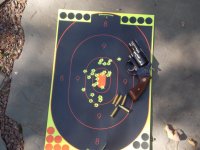Unfortunatly?
What makes it unfortunate that law abiding citizens can legally do what criminals are doing illegally? Even if they are not vetted to YOUR comfort and trained to YOUR standards.
"some yahoo with poor judgement"
JMHO you're the one with "poor judgement" and self-righteous to boot. What makes you think that everyone that avails themselves to constitutional carry has poor judgement? Oh thats right they haven't ask your (or someone like you) permission to exercise "mah rights…”
"who has not (yet) been convicted of a crime"
I could very well be wrong, but I suspect you're a LEO (someone that ENFORCES the law/ US VS THEM) as opposed to a Police officer (someone that helps police the community.) That sir is a pretty G.D. arrogant statement. May I not so politely say bugger off.

Ironically enough I left law enforcement as it was clear it was moving away from what i felt it needed to be. Instead of order maintenance and values based on the concept of law enforcement existing to “to serve and protect” I saw it going down the rat hole of militarizing with attitudes of “us versus the civilians” and “whatever it takes to get home tonight”, with a increasingly frequent sprinkling of “we write the reports”.
The “Unfortunately” in my previous post was just a much a reflection on the changing values I’ve seen in this country over the last 40 years. Way too many Americans have become increasingly less tolerant of those different than themselves, and many of those same individuals as well as others have forgotten that each and every right we have is accompanied by a commensurate degree of responsibility to wield that right in a manner that does not infringe on the rights of others.
Now, we are overlaying constitutional carry on to values that show ever diminishing respect for the rights of others.
I was born and raised in SD and spent about half my adult life there. About 1 in 11 adults had a concealed carry permit, even before they adopted Constituional carry. The permit fee was $5 for decades and then double to $10. It took about a week from application to permit.
SD added a couple of advanced permits with greater fees and training requirements, but those were tailored for residents who wanted improved reciprocity with other states and in particular it’s neighbor MN. But the basic $10 permit was still available.
SD didn’t need a Constitutional carry permit. Now and in the near future, I don’t think it will be a problem in SD as it’s still a state where personal responsibility and getting along with your neighbors are still fairly strong values. That’s ironically because of the high probability of the person someone provokes being armed. Not surprisingly crime rates, outside the two major metropolitan areas and a couple of the reservations, are still low.
That’s not the case in some other state where Constitutional carry has become the law. In those states the simple reality is that Constitutional carry increases the potential for some one to be carrying a gun who might a lot be less responsible than someone with a concealed carry permit.
The saving grace for concealed carry permit holder will be the data base connections in many states between concealed carry permits, VDLs, and vehicle tags. It’ll give officers a heads up that the driver might have a concealed carry permit and be less of a risk of he or she is carrying a gun.
I accurately called the ball on where law enforcement was headed and I don’t like here it’s at as a profession or what it’s become in many departments - but don’t for a minute think I don’t fully support officer safety and take a hard looked at increase threats to officers.



